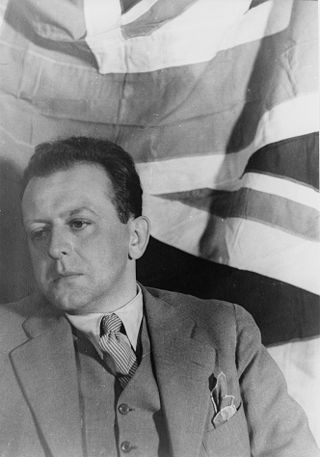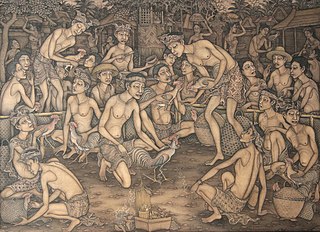
Gamelan is the traditional ensemble music of the Javanese, Sundanese, and Balinese peoples of Indonesia, made up predominantly of percussive instruments. The most common instruments used are metallophones and a set of hand-drums called kendang, which keep the beat. The kemanak, a banana-shaped idiophone, and the gangsa, another metallophone, are also commonly used gamelan instruments on Bali. Other notable instruments include xylophones, bamboo flutes, a bowed string instrument called a rebab, and a zither-like instrument called a siter, used in Javanese gamelan. Additionally, vocalists may be featured, being referred to as sindhen for females or gerong for males.

Colin Carhart McPhee was a Canadian-American composer and ethnomusicologist. He is best known for being the first Western composer to make a musicological study of Bali, and to develop American gamelan along with fellow composer Lou Harrison. He wrote original music influenced by that of Bali and Java, decades before such compositions that were based on world music became widespread.

Pelog is one of the essential tuning systems used in gamelan instruments that has a heptatonic scale. The other, older, scale commonly used is called slendro. Pelog has seven notes, but many gamelan ensembles only have keys for five of the pitches. Even in ensembles that have all seven notes, many pieces only use a subset of five notes, sometimes the additional 4th tone is also used in a piece like western accidentals.

Evan Ziporyn is an American composer of post-minimalist music with a cross-cultural orientation, drawing equally from classical music, avant-garde, various world music traditions, and jazz. Ziporyn has composed for a wide range of ensembles, including symphony orchestras, wind ensembles, many types of chamber groups, and solo works, sometimes involving electronics. Balinese gamelan, for which he has composed numerous works, has compositions. He is known for his solo performances on clarinet and bass clarinet; additionally, Ziporyn plays gender wayang and other Balinese instruments, saxophones, piano & keyboards, EWI, and Shona mbira.

Michael Tenzer is a composer, performer, and music educator and scholar.

The angklung is a musical instrument from the Sundanese in Indonesia that is made of a varying number of bamboo tubes attached to a bamboo frame. The tubes are carved to produce a resonant pitch when struck and are tuned to octaves, similar to Western handbells. The base of the frame is held in one hand, while the other hand shakes the instrument, causing a repeating note to sound. Each performer in an angklung ensemble is typically responsible for just one pitch, sounding their individual angklung at the appropriate times to produce complete melodies.

The Balinese people are an Austronesian ethnic group native to the Indonesian island of Bali. The Balinese population of 4.2 million live mostly on the island of Bali, making up 89% of the island's population. There are also significant populations on the island of Lombok and in the easternmost regions of Java.

A gangsa is a type of metallophone which is used mainly in Balinese and Javanese Gamelan music in Indonesia. In Balinese gong kebyar styles, there are two types of gangsa typically used: the smaller, higher pitched kantilan and the larger pemade. Each instrument consists of several tuned metal bars each placed over an individual resonator. The bars are hit with a wooden panggul, each producing a different pitch. Duration of sound intensity and sound quality factors are generally accomplished by damping the vibration of the bar with the fingers of the free hand. Balinese gong kebyar gangsas, as with other metallophones in gong kebyar ensembles, are played in neighboring pairs with interlocking, rapid-tempo parts that elaborate on the melody of a piece of music ; these pairs are tuned to be dissonant and create certain wavelengths of sympathetic vibrations to create a shimmering tone that travels long distances. The gangsa is very similar to the old gendér and the saron.
I Made Bandem is a Balinese dancer, artist, author, and educator.

Gamelan Sekar Jaya is a Balinese gamelan ensemble located in the San Francisco Bay Area. It has been called "the finest Balinese gamelan ensemble outside of Indonesia" by Indonesia's Tempo Magazine. It performs the music and dance of Bali in many different genres of Balinese gamelan, mainly gamelan gong kebyar, gamelan angklung, gender wayang, and gamelan jegog. Past performances have also featured ensembles playing in other styles as well, including gamelan joged bumbung, gamelan semar pegulingan, kecak, gender batel, gamelan gambuh, genggong, and beleganjur. GSJ has also performed contemporary pieces featuring instruments from the Western tradition.

Gamelan gender wayang is a style of gamelan music played in Bali, Indonesia. It is required for wayang and most sacred Balinese Hindu rituals. The smallest of gamelan ensembles, it requires only two players and is complete at four, the additional instruments doubling an octave above. Like other gamelan genres, it incorporates delicate interlocking melodies and active contrapuntal movement, yet poses unique challenges in technique and composition.
Loren Nerell is an American composer and performer of ambient American music and Balinese gamelan.

Balinese art is an art of Hindu-Javanese origin that grew from the work of artisans of the Majapahit Kingdom, with their expansion to Bali in the late 14th century. From the sixteenth until the twentieth centuries, the village of Kamasan, Klungkung, was the centre of classical Balinese art. During the first part of the twentieth century, new varieties of Balinese art developed. Since the late twentieth century, Ubud and its neighboring villages established a reputation as the center of Balinese art.

Richard Marriott is an American composer and performer. He has composed for film, television, dance, theater, opera, installations and video games. He is the founder and artistic director of the Club Foot Orchestra, an important modern ensemble for live music performance with silent films. His teachers include Dominick Argento and Paul Fetler at the University of Minnesota, Pauline Oliveros at UCSD, North Indian sarod master Ali Akbar Khan, shakuhachi master Masayuki Koga, and Balinese composers Nyoman Windha and Made Subandi. Marriott was a member of Snakefinger's History of the Blues and has recorded with The Residents, Brazilian Girls, "Singer at Large" Johnny J. Blair, and many others. He performs on brass and woodwind instruments, Western and Asian.
I Wayan Suweca is a highly respected performer of Balinese gamelan. Since the 1970s, he has taught and performed extensively throughout Asia, Europe, and America. In the early 1980s, along with his students Michael Tenzer and Rachel Ann Cooper, he founded and led the famous Sekar Jaya gamelan ensemble in Berkeley, California. In 1993, he cofounded the ensemble Giri Kedaton in Montreal. From 1982 to 2004, he was professor at the National Arts Academy of Indonesia (STSI) in Bali. From 1987 to 1993, he was a guest teacher at Université de Montréal in Canada and in Rochester, USA. For other students, See: List of music students by teacher: R to S#I Wayan Suweca.
I Nyoman Renbang (1937–2001) was an Indonesian musician, composer, teacher and instrument maker. He is considered by many ethnomusicologists as one of the most influential Balinese musicians and composers of the twentieth century.

The Puri Lukisan Ratna Wartha Museum is the oldest art museum in Bali which specialize in modern traditional Balinese paintings and wood carvings. The museum is located in Ubud, Bali, Indonesia. It is home to the finest collection of modern traditional Balinese painting and wood carving on the island, spanning from the pre-Independence war (1930–1945) to the post-Independence war era. The collection includes important examples of all of the artistic styles in Bali including the Sanur, Batuan, Ubud, Young Artist and Keliki schools.

Elaine "Ray" Barkin was an American composer, writer, and educator.

Gambuh is an ancient form of Balinese dance-drama. It is accompanied by musicians in a gamelan gambuh ensemble.

Condong is a Balinese dance which is often performed as a preface to legong and accompanied by the semar pangulingan style of gamelan. The term also refers to a stock character, a quintessential representation of the maidservant, found in the condong dance as well as the legong, gambuh, and arja dances.


















